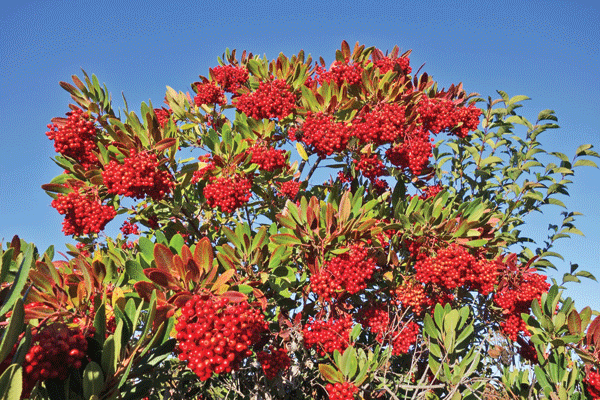
Early on one of those freezing mornings I came across a large stand of California native toyon shrubs, every branch covered with juicy red berries. Dozens of songbirds were enjoying the feast, loading up and bracing for another cold night. You couldn’t ask for a more Christmas-ey plant. Bright red and green — the Christmas colors. I made a note to put toyon on my list for gift ideas. What would be better than to give my loved ones something that feeds the birds and the spirit?
Toyon is a hardy shrub in our area no matter how low the temps drop. Many of the plants in your garden may not be so lucky after the multiple nights of freezing weather we’ve recently experienced. Even if you covered sensitive plants, a hard frost can nip plants that normally would be fine in a light frost. Here’s how to deal with frost damage.
Don’t be tempted to rush out and prune away the damaged parts of plants. This winter will have more cold weather and the upper part of your plant, even if damaged, can protect the crown from further freezing and provide protection for tender new buds and shoots coming along for next year. This applies to citrus trees, too. If a perennial like Mexican sage froze to a gooey, black mess, cut the plant down to the ground. It will re-grow come spring from the root system.
Remember If you have plants that need covering before another frost later this winter, use a frost blanket, light towel, sheets, burlap or other type of cloth and not plastic. The cold will go right through plastic and damage the plant.
Getting back to my Christmas list, everybody loves color in the winter garden. Besides toyon berries to feed the birds and other wildlife, Strawberry trees have fruit for much of the winter as do crabapples, beautyberry, pyracantha and nandina if the robins don’t get them first.
Mahonia or Oregon grape will be blooming soon and their yellow flowers would look great with golden Iceland poppies. Many of their leaves are purplish or bronze now that the nights have gotten cold and are very colorful. Hummingbirds favor their flowers and many songbirds eat the delicious berries.
For those really dark places, fragrant sarcococca is perfect, combined with red primroses and will be blooming very soon. You can smell their perfume from a long distance. Hellebores bloom in the winter, too, and offer texture in your containers. A variegated osmanthus will hold up in even our harshest weather and would be a show stopper in a Chinese red container.
If the idea of sitting under a beautiful shade tree in the summer would appeal to the gardener on your list, you might consider giving them a Paul’s Scarlet Hawthorn that’s covered in masses of rosy blossoms in the spring and colorful berries in the winter. October Glory Maple is a great tree for shade and gorgeous fall color. Autumnalis Flowering Cherry blooms twice a year giving you double the show. Mine is in the middle of its fall blooming cycle right now. It’s a welcome sight. A smaller Southern Magnolia like ‘Little Gem’ with huge fragrant white flowers would also make a nice gift.
These are just a few of the shade and ornamental trees that would make a valuable addition to any landscape. Visit a nursery to look for those plants with berries and winter color for other gift ideas.
– Jan Nelson, a landscape designer and California certified nursery professional, will answer questions about gardening in the Santa Cruz Mountains. E-mail her at ja******@*ol.com, or visit www.jannelsonlandscapedesign.com to view past columns and pictures.












